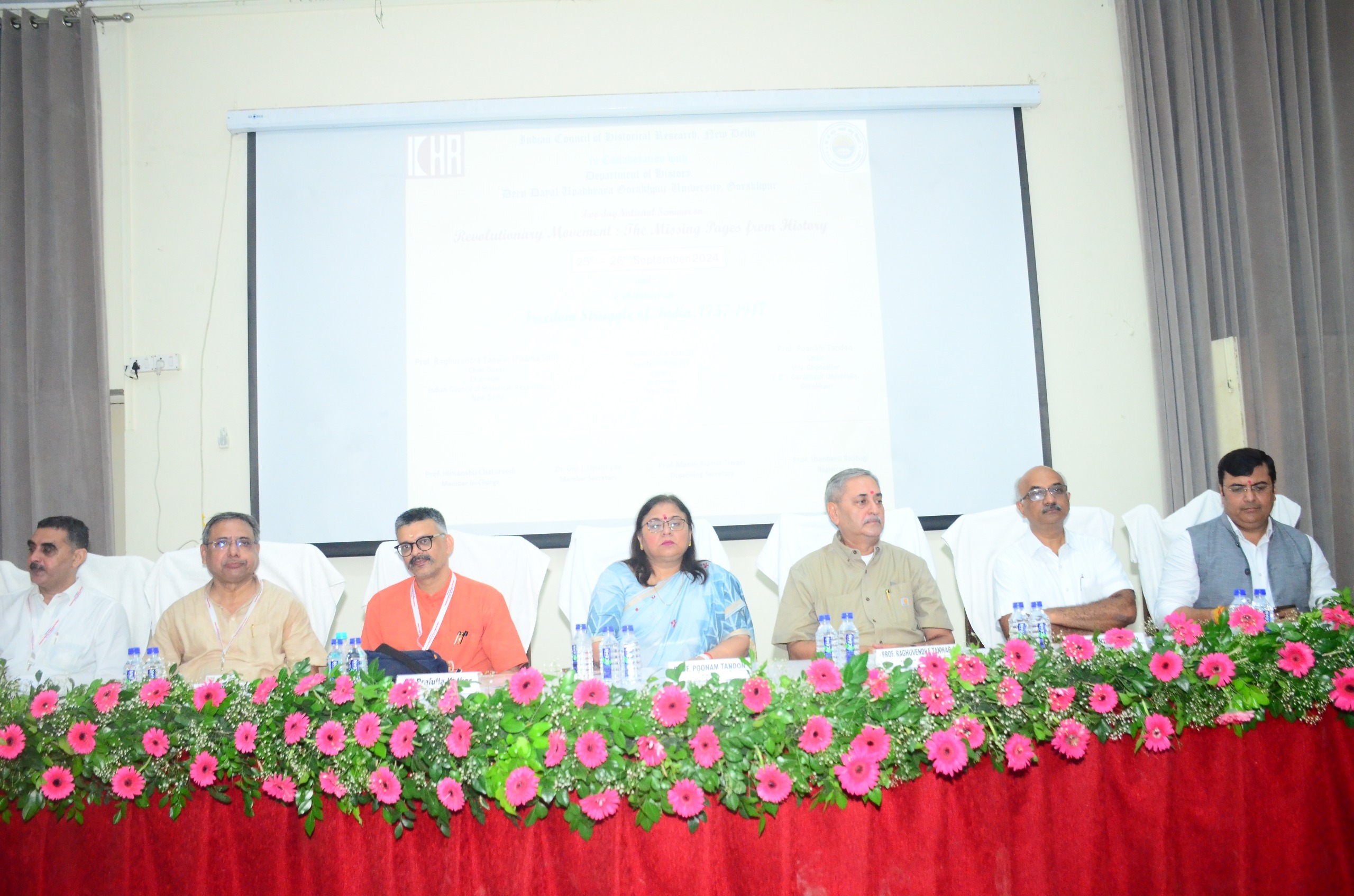Gorakhpur, 25 September (HS). While presiding over the inaugural session of the national seminar organized under the joint aegis of Deendayal Upadhyaya Gorakhpur University and Indian Council of Research on Wednesday, Vice Chancellor Prof. Poonam Tandon said that there is a need to look at history in its entirety. It is necessary to constantly examine and identify history in the light of new research and facts. The university is the center of production of knowledge. Such discussions and seminars are of great importance in the direction of meaningful change. This process of thinking will continue in the future as well. This seminar is a meaningful tribute on the 108th birth anniversary of Deendayal ji.
ICHR President Padmashri Prof. Raghuvendra Tanwar, while showing violent revolutionary activities and the behavior of the British government with non-violent agitators, made it clear that narratives have fundamental importance in history writing. The history writing of the freedom struggle needs a new narrative. This narrative should not be inspired by emotions but should be based on facts and events. Anyway, the stream of Indian history writing has become quite old. Indian history writing also needs a liberation. Now those revolutionaries are being recorded in history who were anonymous till now.
Delivering the keynote address of the inaugural session, Prafull Ketkar, editor of Organiser, said that the nature of the Indian freedom struggle was extensive. As the nature of European invasion changed, the nature of our resistance also changed. Swadharma, Swadeshi, Swabhasha-Rashtriya Shiksha and Swaraj were its gradual development. Political independence was only a part of our freedom struggle. All sections of Indian society, all regions and worship systems resisted the European invasion. This resistance was done from Satyagraha to armed struggle on various fronts. This struggle began with the arrival of Vasco da Gama. Till 1857, 376 such wars took place which are an important part of the freedom struggle.
He said that I am sure that this seminar will inspire us to study India's freedom struggle in its entirety by going beyond its narrow form. The cultural concept of India desired by Pandit Deendayal ji will be established on that basis.
In his address, Dr. Om Ji Upadhyay, the promoter of the topic of the seminar and member secretary of ICHR, said that at least 8 streams of the freedom struggle were flowing with full strength. But unfortunately the entire history-writing remained focused on only one stream. In this, the stream of cultural nationalism, which was providing ideological nourishment to the entire movement, was also pushed to the margins. While writing Vande Mataram, Bankim Chandra was equating Bharat Mata and Maa Durga. Swami Vivekananda, after meditating for three days in Kanyakumari in the year 1892, gave his conclusion that there is no difference between Bharat Mata and Maa Jagdamba. Lokmanya Bal Gangadhar Tilak was fighting the freedom struggle through “Ganpati Utsav” and “Shivaji Utsav”. At the same time, when Bhaiji Hanuman Prasad Poddar was publishing the Gita for the first time in Kolkata, he was publishing the picture of Bharat Mata holding a sword on its main page. This stream of cultural nationalism gave immense energy and enthusiasm to all the streams of the entire freedom struggle.
He said that the second most important stream, which did not get as much importance in history writing as it should have, was the stream of revolutionary movement. Thousands of young revolutionaries were sacrificing their lives to free their motherland from the shackles of slavery. Unfortunately, an attempt was made to tell our generations that we got this freedom without sword and shield, whereas the truth is exactly the opposite.
The speakers said that four lakh people were sacrificed in the great war of 1857. In Delhi, whose population was only 152000, 27000 people were hanged. In Lucknow, more than 20000 revolutionaries were hanged. In Allahabad, the bodies hanging on trees for two months were taken away on bullock carts. Such a gruesome description is not found anywhere else in the written history of the world. This echo of the revolution, which was already going on, continued to grow continuously till 1947. In 1870, the Kuka movement in which 68 Kukas were tied to a cannon and blown up and in this incident, the bravery of 13-year-old Bishan Singh, who pulled out the beard of the British Commissioner Cowen who gave this order with both hands and also sacrificed his life. The valour of Vasudev Balwant Phadke, Chapekar brothers in Maharashtra, Yuvraj Tikendrajit Singh in Manipur, Bhagwan Birsa Munda, Arvind Ghosh, Varindra Ghosh, Bhupendra Dutt etc. in Bihar is exemplary. We have included a list of 160 martyrs below the age of 20 in our visual exhibition, which includes heroes like Baji Raot, Kalibai, Khudiram Bose, Prafulla Chaki, Kanaklata Barua, whose valour has never been praised in history writing.
The speakers said that the speech given by revolutionary Madanlal Dhingra before being hanged is a wonderful legacy in the written history of the world, when he says that slavery is an insult to my nation, an insult to my God and also that worshipping the nation is like worshipping Ram and serving the nation is like serving Krishna. When Ramprasad Bismil is hanged in Gorakhpur, he is reciting Vedic mantras and proclaiming Vande Mataram. Ashfaq Ullah was the first revolutionary who was hanged while reciting Kalma. Similarly, there were brave revolutionaries in every corner of the country, now it is time that our new generations should know their true and authentic history. A total of 26000 braves sacrificed their lives in Netaji's Azad Hind Fauj, there are many such incidents, on the basis of which the imbalance and discussion in history writing needs to be corrected.
 look news india
look news india
